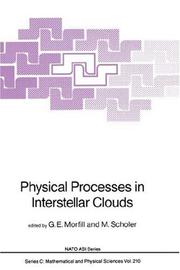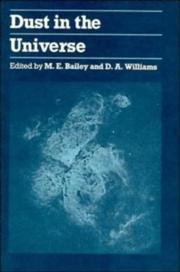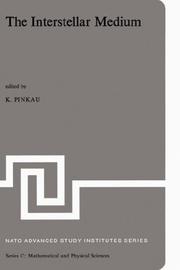| Listing 1 - 10 of 63 | << page >> |
Sort by
|
Periodical
Abstract | Keywords | Export | Availability | Bookmark
 Loading...
Loading...Choose an application
- Reference Manager
- EndNote
- RefWorks (Direct export to RefWorks)
astrophysics --- astronomy --- interstellar medium

ISBN: 9027725632 9401082502 9400939450 Year: 1987 Volume: vol 210 Publisher: Dordrecht Boston Tokyo Reidel
Abstract | Keywords | Export | Availability | Bookmark
 Loading...
Loading...Choose an application
- Reference Manager
- EndNote
- RefWorks (Direct export to RefWorks)
Interstellaire materie --- Interstellar matter --- Interstellar medium --- Matière interstellaire --- 524.5 --- -Interstellar medium --- Astrophysics --- Matter --- Space environment --- Interstellar reddening --- Interstellar medium. Galactic nebulae --- Congresses --- Congresses. --- -Interstellar medium. Galactic nebulae --- 524.5 Interstellar medium. Galactic nebulae --- -524.5 Interstellar medium. Galactic nebulae
Book
ISBN: 0674460758 Year: 1970 Publisher: Cambridge, Mass. Harvard University Press
Abstract | Keywords | Export | Availability | Bookmark
 Loading...
Loading...Choose an application
- Reference Manager
- EndNote
- RefWorks (Direct export to RefWorks)
Galaxies --- 524.5 --- Interstellar matter --- Interstellar medium --- Astrophysics --- Matter --- Space environment --- Interstellar reddening --- Interstellar medium. Galactic nebulae --- Interstellar matter. --- 524.5 Interstellar medium. Galactic nebulae
Book
ISBN: 0470817100 9780470817100 Year: 1968 Volume: 28 Publisher: New York (N.Y.): Wiley,
Abstract | Keywords | Export | Availability | Bookmark
 Loading...
Loading...Choose an application
- Reference Manager
- EndNote
- RefWorks (Direct export to RefWorks)
Interstellar matter --- 524.5 --- Interstellar medium --- Astrophysics --- Matter --- Space environment --- Interstellar reddening --- Interstellar medium. Galactic nebulae --- Interstellar matter. --- 524.5 Interstellar medium. Galactic nebulae
Book
ISBN: 128096183X 9786610961832 2759802809 1417561467 9781417561469 9781280961830 9782759802807 Year: 2002 Publisher: Les Ulis [France] : EDP Sciences,
Abstract | Keywords | Export | Availability | Bookmark
 Loading...
Loading...Choose an application
- Reference Manager
- EndNote
- RefWorks (Direct export to RefWorks)
New stars are continuously being born out of interstellar matter. This work is for advanced students and researchers. It gives a gradual and thorough description of the interstellar environment of its physics and chemistry.
Interstellar matter. --- Interstellar medium --- Astrophysics --- Matter --- Space environment --- Interstellar reddening
Dissertation
ISBN: 9789086496839 Year: 2013 Publisher: Leuven Katholieke Universiteit Leuven
Abstract | Keywords | Export | Availability | Bookmark
 Loading...
Loading...Choose an application
- Reference Manager
- EndNote
- RefWorks (Direct export to RefWorks)
Low-to-intermediate mass stars end their life on the asymptotic giant branch (AGB), an evolutionary phase in which the star sheds most of its mantle into the circumstellar environment through a stellar wind. This stellar wind expands at relatively low velocities and enriches the interstellar medium with elements newly made in the stellar interior. The physical processes controlling the gas and dust chemistry in the outflow, as well as the driving mechanism of the wind itself, are poorly understood and constitute the broader context of this thesis work.In a first chapter, we consider the thermodynamics of the high-density wind of the oxygen-rich star OH 127.8+0.0, using observations obtained with the PACS instrument onboard the Herschel Space Telescope. Being one of the most abundant molecules, water vapor can be dominant in the energy balance of the inner wind of these types of stars, but to date, its cooling contribution is poorly understood. We aim to improve the constraints on water properties by careful combination of both dust and gas radiative-transfer models. This unified treatment is needed due to the high sensitivity of water excitation to dust properties. A combination of three types of diagnostics reveals a positive radial gradient of the dust-to-gas ratio in OH 127.8+0.0. The second chapter deals with the dust chemistry of carbon-rich winds. The 30-µm dust emission feature is commonly identified as due to magnesium sulfide (MgS). However, the lack of short-wavelength measurements of the optical properties of this dust species prohibits the determination of the temperature profile of MgS, and hence its feature strength and shape, questioning whether this species is responsible for the 30-µm feature. By considering the very optically thick wind of the extreme carbon star LL Peg, this problem can be circumvented because in this case the short-wavelength optical properties are not important for the radial temperature distribution. We attribute the 30-µm feature to MgS, but require that the dust species is embedded in a heterogeneous composite grain structure together with carbonaceous compounds.The final chapter considers the circumstellar gas chemistry of carbon-rich AGB stars. The recent discovery of warm water vapor in carbon-rich winds challenges our understanding of chemical processes ongoing in the wind. Two mechanisms for producing warm water were proposed: water formation induced by interstellar ultraviolet photons penetrating into the inner region of a clumpy wind, and water formation induced by shocks passing through the atmospheric and inner-wind molecular gas. A sample of eighteen carbon-rich AGB stars has been observed with the Herschel Space Telescope and offers insights into the dependence of water properties on the stellar and circumstellar conditions. We suggest that both proposed water formation mechanisms must be at work to account for the following findings: 1) warm water is present in all observed carbon stars; 2) water formation efficiency decreases with higher circumstellar column density; 3) water properties strongly depend on the variability characteristics of the AGB stars; and 4) a positive water abundance gradient is present up to at most ~ 50 stellar radii in individual star
Book
ISBN: 0198514581 9780198514589 Year: 1978 Publisher: Oxford: Clarendon,
Abstract | Keywords | Export | Availability | Bookmark
 Loading...
Loading...Choose an application
- Reference Manager
- EndNote
- RefWorks (Direct export to RefWorks)
Cosmic dust --- 524.5 --- Dust --- Interstellar matter --- Interstellar medium. Galactic nebulae --- Cosmic dust. --- 524.5 Interstellar medium. Galactic nebulae
Book

ISBN: 0720403286 0444108564 Year: 1975 Volume: 26/1974 Publisher: Amsterdam : New York : North-Holland publishing company ; American Elsevier publishing company,
Abstract | Keywords | Export | Availability | Bookmark
 Loading...
Loading...Choose an application
- Reference Manager
- EndNote
- RefWorks (Direct export to RefWorks)
524.5 --- Interstellar medium. Galactic nebulae --- 524.5 Interstellar medium. Galactic nebulae --- Interstellar matter --- Molecules --- Atoms --- Matière interstellaire. --- Molécules. --- Atomes.

ISBN: 052135580X 9780521355803 Year: 1988 Publisher: Cambridge : Cambridge university press,
Abstract | Keywords | Export | Availability | Bookmark
 Loading...
Loading...Choose an application
- Reference Manager
- EndNote
- RefWorks (Direct export to RefWorks)
Cosmic dust --- Astronomical spectroscopy --- Interstellar matter --- Congresses --- 524.5 --- -Astronomical spectroscopy --- -Interstellar matter --- -Interstellar medium --- Astrophysics --- Matter --- Space environment --- Interstellar reddening --- Spectroscopy, Astronomical --- Absorption spectra --- Spectrum analysis --- Dust --- Interstellar medium. Galactic nebulae --- -Interstellar medium. Galactic nebulae --- 524.5 Interstellar medium. Galactic nebulae --- -Astrophysics --- Interstellar medium --- -524.5 Interstellar medium. Galactic nebulae --- Cosmic dust - Congresses --- Astronomical spectroscopy - Congresses --- Interstellar matter - Congresses

ISBN: 9027704171 940102152X 9401021503 9789027704177 Year: 1974 Volume: 6 Publisher: Dordrecht : Reidel,
Abstract | Keywords | Export | Availability | Bookmark
 Loading...
Loading...Choose an application
- Reference Manager
- EndNote
- RefWorks (Direct export to RefWorks)
Interstellar matter --- Congresses --- 524.5 --- -#KVIV --- #WSTE:STER --- Interstellar medium --- Astrophysics --- Matter --- Space environment --- Interstellar reddening --- Interstellar medium. Galactic nebulae --- Congresses. --- 524.5 Interstellar medium. Galactic nebulae --- #KVIV --- Interstellar matter - Congresses
| Listing 1 - 10 of 63 | << page >> |
Sort by
|

 Search
Search Feedback
Feedback About UniCat
About UniCat  Help
Help News
News